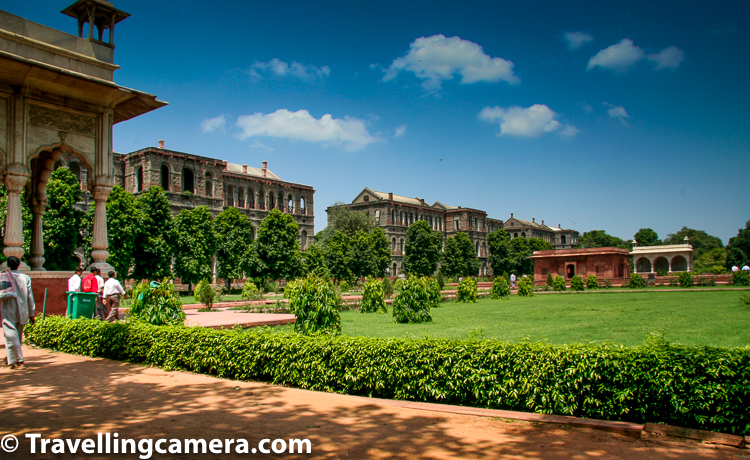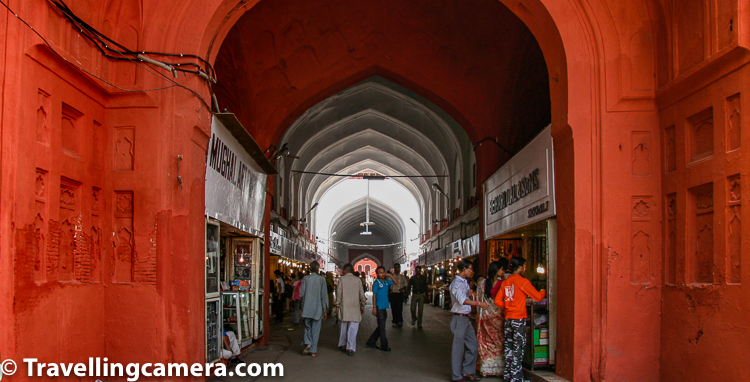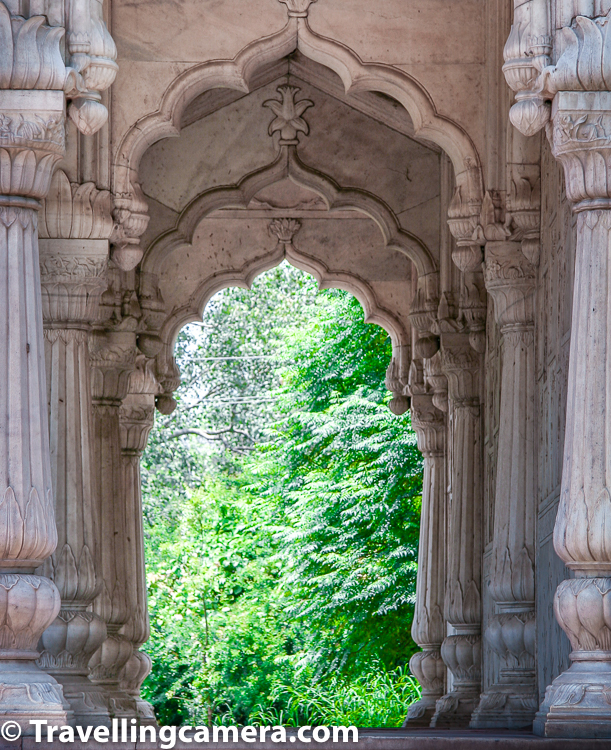Red Fort is one of the 3 World Heritage sites in Delhi and the other 2 important world heritage sites in capital city of India are - Qutub Minar & Humayun's Tomb. I remember my first visit to Delhi with my maternal grandfather. The first place he showed me in Delhi was Red Fort. There are multiple reasons why Red Fort is so special. It has very interesting historical stories associated and one of the most important national events takes place at Red Fort & country's Prime Minister addresses the nation from top of it through all media channels across of the country relaying it. I can imagine some India don't know about other important World Heritage sites in Delhi but there is very less probability of that happening in case of Red Fort.
Above is the view of Red Fort entry from the side along with long queue of people want to visit Red Fort. There is an entry ticket to go inside. After getting entry ticket, one needs to queue up to enter into this huge monument in Delhi. And typically Red Fort is open from Sunrise till sunset, like many other monuments in Delhi.
Above photograph shows Lahori gate of Red Fort. The Lahori Gate is the main gate to the Red Fort, which is named for its orientation towards the city of Lahore. Every year on India's Independence Day, the prime minister hoists the Indian flag at Red Fort's main gate and delivers a nationally broadcast speech. During older times, The Lahori and Delhi Gates were used by the public, and the Khizrabad Gate was for the emperor.
Entry Ticket fees for Red Fort in Delhi -
90 Rs - For Indians
950 Rs - For Non-Indians
25 Rs - Photography
80 Rs - Evening Light & Sound show for adults
30 Rs - Evening Light & Sound show for kids
As you go inside the Red Fort, you see lot of Mughal architecture along with British architecture. Above photograph shows some of the structures built during British era in India. These are British Army Barracks and that's how they look very different than other structures inside Red Fort.
These institutional buildings are all quite pleasant with varied and with modest but quite attractive decorative touches, large cooling archways and brilliant stone work. William Dalrymple calls them - "some of the most crushingly ugly buildings ever thrown up by the British Empire"
Above photograph shows Diwan-e-khas - Hall of Private Audience with main dignitaries. Diwan-e-khas is constructed of white marble as you can see in this photograph and surrounded by beautiful & lush lawns visible in the photograph. When you go close to it you will be able to appreciate some of the artistic and technical marvels of Red Fort. This space used to have water streams running under the structure to keep the space cool. It's open from 3 sides with netted wall on fourth side that makes the space airy. If you look at the walls and pillars of this space, you would see some beautiful carvings. It seems some of these designs had silver which is not visible now, but it gives great exposure of art-forms of Mughal times.
The Red Fort has an area of 250+ acres which is enclosed by 2.4+ kilometres of outer walls of Red Fort in Delhi. The Red fort is octagonal with beautiful marble, floral decorations and the fort's double domes exemplifying Mughal architecture. Whole architecture is built by keeping Delhi's weather conditions in mind. Look at the bottom part of above photograph which shows path created for continuous water flow through these structure to maintain temprature.
Above photograph shows a tunnel like structure located past the Lahore Gate and there is a market. This market is known as the Chatta Chowk. Supposedly there used to be market during Mughal time as well to fulfil needs of women of Mughal family living in Red Fort at that point of time. Chhatta Chowk (or Meena Bazaar) used to the place to sell silk, jewellery and other items for the imperial household during the Mughal period. This market was earlier known as Bazaar-i-Musaqqaf or Chatta-bazaar.
As of today this market sells stuff to tourists - souvenirs, jewellery and specific kinds of fabric. If you wish to buy anything from this market, you have to be good negotiator.
The Red Fort in Capital city of India used to be main residence of the Mughal Emperors. Emperor Shah Jahan built Red Fort in 1630s, when he wanted to move his capital from Agra to Delhi. Red Fort was architected by Ustad Ahmad Lahori who also constructed the Taj Mahal - one of the 7 wonders of the world.
Red Fort showcases a high level of ornamentation and the Kohinoor diamond was reportedly part of the furnishings. Artworks at Red Fort includes Persian, European and Indian arts. All that leaves richness in terms of form, expression and colours.
Red Fort is huge space to explore and one can easily spend half a day inside the fort & even more if interested in finer details of the heritage & history associated with Red Fort in Delhi. All these photographs are clicked 10 years and I would love to visit the place again & click better photographs in next visit.










.jpg)
Comments